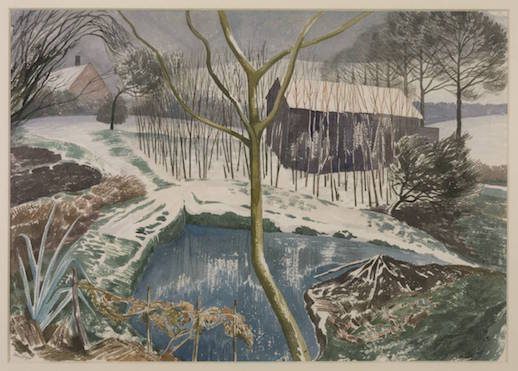 River in winter by John Nash. Via Wormingford blog.
River in winter by John Nash. Via Wormingford blog.
River Diary by Ronald Blythe
Published by Canterbury Press Norwich (2008)
Review by Nic Flook
River Diary is a collection of Ronald Blythe’s weekly articles for Church Times that dates back to 2005‐2006, the year in which his friend Roger Deakin died. It was through reading Roger Deakin’s Notes From Walnut Tree Farm that I irst became intrigued about Ronald Blythe. He lives near the bottom of a long, stony, winding track obscured by the ‘English jungle’ as the previous owner, the artist John Nash, described the yeoman farmhouse on the border of Suffolk and Essex. Ronald Blythe confesses to only leaving the area around Bottengoms farm once or twice a year and his writing is proof that although physically we might be rooted in one place, it doesn’t mean that our thoughts can’t do the travelling for us. Blythe is writer as catalyst, stoking up our imagination with his years of acquired fuel that includes history, nature, religion, art, memoire and a long lifetime of reading and writing. As well as friendships with some of Britain’s best known artists, writers and clergy. The ‘everyday’ of ironing, lost socks, his white cat and the state of his gardening clothes, provide texture to the detailed observations of the changing seasons in his garden, the river and the fields.
If you have read of Roger Deakin’s trips to Tiger Hill, especially when he spent a night under the rookeries or at one of the annual bluebell parties there, then you will be familiar with the landscape. The wood was rescued by Doctor Grace Grif ith, and is now home to badgers, dormice, slow worms, owls, shrews, bats and many of our more precarious native species. Ronald Blythe was his companion in these woods and thoughts of John Keates and John Clare come to mind for him in the ‘psychedelic blueness, stopping now and again to hear the nightingales’ (How Tiger Hill Began, 7th May.) In the chapter, Roger Dying, Blythe reads to Roger Deakin from John Clare’s poem The Nightingale’s Nest and senses Roger listening as keenly as they listened to Nightingales together in Tiger Hill wood. This may have been the last time Ronald Blythe saw his friend and the atmosphere is serene. Sitting by Roger’s deathbed in August, ‘the heatwave fading’, Blythe remarks on the gift of a scythe Roger brought to him from Stowmarket.
This physical gift is something recounted although the spiritual gifts exchanged between these two people from remote corners of East Anglian, with their knowledge and compassion for nature, are I suspect more dif icult to put into words. A prayer by John Donne is said and precedes the line, ‘we kiss and leave.’
As with Blythe’s other collections, the accounts in River Diary are woven with Saville Row precision and all subject matter elides with such economy of language that in a few hundred words you can take in the view from the track where Blythe walks to collect his newspaper and milk, to memories of the stone pickers voices from the ields, images of John Constable walking by to visit relatives in the village or what the lives of commuters might be like. The writing mimics the natural eclecticism of the artist’s brain and it was from artists like John Nash and Cedric Morris that Blythe learned to how to ‘really look’ at the world around him and his writing gently encourages us to do the same because ‘wherever we stroll, the way belongs to us.’
Editor’s note: reading this review from Nic took us back to February 2013 and a lovely piece written by Bob Jellicoe reflecting on an event which had take place at the Corn Hall in Diss to celebrate what would haver been Roger Deakin’s 70th birthday. Read it here.
Nic Flook on Twitter: @incessantflux